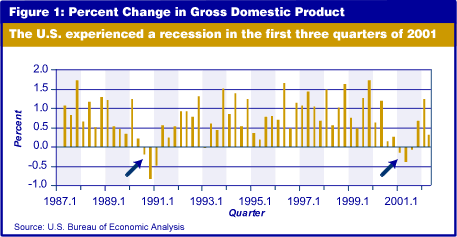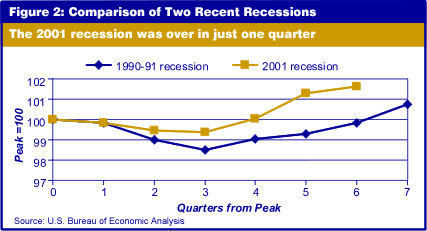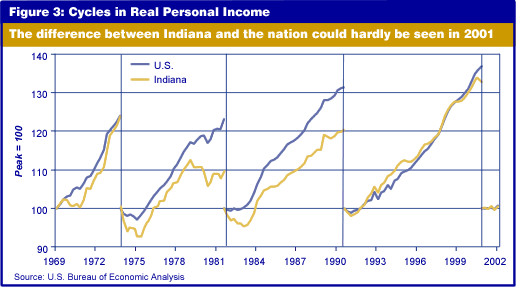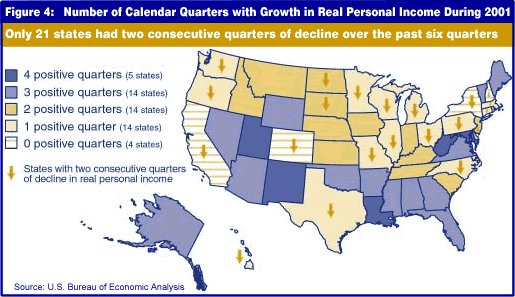The Recession of 2001
The standard way of defining a recession looks at the value of economic output adjusted for inflation. This measure is known as Real Gross Domestic Product (GDP). Two consecutive quarters of decline in Real GDP is generally considered to be a recession. By this definition, the U.S. had a recession in the first three quarters of 2001 (see Figure 1).

This most recent recession was equal in duration to the recession of 1990 (three quarters) but was not as severe, and the economy did not take as long to recover. Figure 2 shows how each recession proceeded from its prior peak. In the 1990-91 recession, GDP fell 1.5 percent from its peak in the second quarter of 1990. The 2001 recession saw a 0.6 percent decline from the peak in the fourth quarter of 2000.

The U.S. economy took a year to exceed its prior peak in the 1990-91 business cycle. The 2001 recession was over in just one quarter.
Many people, however, are reacting to the recent recession as if it were the mother of all economic calamities. Part of this response is due to the dramatic decline in the stock market, which gets considerable press attention and which, because of more wide-spread stock ownership, is of greater importance to people than it would have been in the past.
Another part of the response is traditional. Many people have never seen a business cycle in their active economic lives. If we assume 20 years of age is the average entry age into the full-time civilian labor force, people who are under 31 years old today never saw a recession. That is approximately 2.7 million people in Indiana and 123 million nationwide.
Figure 3 demonstrates how recent recessions have been experienced in Indiana and the U.S. The measure here is real personal income as reported by the U.S. Bureau of Economic Analysis. From this graph it becomes very clear that the 2001 recession was not comparable with prior recessions.

In earlier recessions, the decline from the peak was more severe than in the 2001 recession. In each recession Indiana suffered more than the nation. But the most recent decline barely shows up as a recession at all and there is little disparity between Indiana and the U.S. as a whole. Where the nation showed a decline from the peak (in 2000:4) of 0.32 percent, Indiana was close behind with a decline of just 0.34 percent. By the first quarter of 2002, the U.S. recovered to 0.78 percent above the prior peak and Indiana-at 0.50 percent above its prior peak-was one of 21 states to recover from the recession.
Figure 4 indicates that four states failed to have even one quarter of growth in real personal income during 2001. Because these four included California and New York, they had a great influence on national data and the media. Indiana was one of 14 states with two positive quarters in 2001. Kentucky matched us in that regard, but our other neighbors, Michigan, Illinois and Ohio, only had a single quarter of growth. Five states enjoyed a year in which there was no decline at all in personal income. In fact, only 21 states had two consecutive quarters of decline in real personal income over the past six quarters. Indiana was not one of them.

Thus, the recent recession was shallow, short and of limited geographic dispersion. We must await revisions to the data before any conclusive statements can be made. Despite the feelings of our citizens and the rhetoric of some politicians, this economy may not be as bad as we have been believing.
Morton J. Marcus
Executive Director, Indiana Business Research Center,
Kelley School of Business, Indiana University
